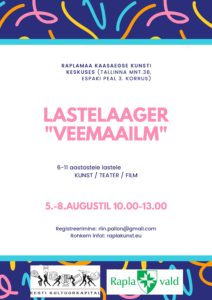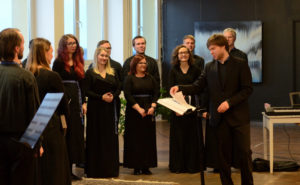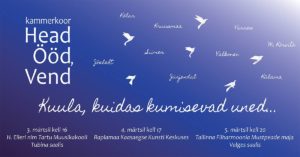Art camp for ages 6-11
5.-8. august 10.00-13.00
Registration:
riin.pallon @ gmail.com
Lisainfo:
Riin 55 633 849

Art camp for ages 6-11
5.-8. august 10.00-13.00
Registration:
riin.pallon @ gmail.com
Lisainfo:
Riin 55 633 849

An exhibition by artists from the Mecklenburg-Vorpommern of Germany, focusing on topics related to a sense of place. The works deal with a search for a place of one’s own in a rapidly changing world.
The exhibition also features screenings of films about German modern art.
The exhibition is part of the programme “German Spring 2019” devoted to bringing German culture to the Estonian audience.
Kunstausstellung „Wir sind da“
Teilnehmende KünstlerInnen: Wolfgang Tietze (Gemälde), Daniela Melzig (Glasdruck) und Kristin Meyer (Installation).
Am 5. April um 18 Uhr wird im Raplamaa Kaasaegse Kunsti Keskus eine Kunstausstellung von Künstlern eröffnet, die Teilweise aus Mecklenburg-Vorpommern stammen. Die Werke behandeln durch verschiedene Weise Themen, die mit Orten und Plätzen verbunden sind. In den Werken geht es darum, wie man in der zeitgenössischen und immer schneller werdenden Welt seinen Platz findet.
Movie nights (free entrance) – Filmabends (Eintritt frei)
10. aprill kell 18.00 Gerhard Richter – Painting
16. aprill kell 18.00 Joseph Beuys – Jeder Mensch ist ein Künstler
26. aprill kell 18.00 Paula Modersohn-Beckeri looming
Mathura / Kaari Saarma
„I am the Gardener“
The joint exhibition of artist Mathura and photographer Kaari Saarma intuitively scans one’s chance to be his or her own gardener. A garden is alive when both the wild and the cultivated get their share. The work is carried by the sense of directing your creation, but being unable to predestine its course. The pictures are like stopping points or gateways, the moments of awaiting the new buds.
The exhibition is on at Raplamaa Kaasaegse Kunsti Keskus from November 17 to December 2, Tuesdays to Sundays 3-6 P.M.
Come and join the artists for a tour of the exhibition and hear their story of it in the evening of December 2, at 18:00. All are welcome.
Photos by Kaari Saarma and Heiko Kruusi
“Wishing Well” Varvara Guljajeva ja Mar Canet
https://www.facebook.com/mar.canet/videos/10156804050003792/UzpfSTI4Nzk1ODc2NDYxOTg3MDoxOTA1MzIxMDEyODgzNjI5/
Rapla County Centre For Contemporary Art
Press release
Oct 10, 2018
Artists’ group exhibition redefines Estonia through common key concepts
On Friday, October 12, at 6pm, an exhibition titled Estonia: A Mindscape opens at the Rapla County Centre For Contemporary Art. The opening performance by Alide Zvorovski and Katri Pekri bears the name “Ice Auditorium.”
Curator Kairi Orgusaar says:
“At this exhibition, keywords such as Trust, Word, Light, Freedom, Sound and Sea are expressed in works of art created with them in mind, and directing the viewer to consider the past, as well as the present and the future. Throught truth and humour, this exhibition – part of the Estonia100 anniversary programme – observes Estonia on the human scale.”
Participants include: Mar Canet, Varvara Guljajeva, Erki Kannus, Merle Kannus, Kati Kerstna, Kärt Ojavee, Kairi Orgusaar, Katri Pekri, Alide Zvorovski, Johanna Ulfsak.
WORD: The work “Wishing Wall” by Mar Canet and Varvara Guljajeva revives the magical act of making wishes – creating the future through words – by modern technological means, which give a physical presence to wishes written down by the spectators.
SEA: Kärt Ojavee and Johanna Ulfsak’s project “Live Transmission” conjures a utopian communication session through technological telepathy, where two separate universes converse without visuals or words.
SPACE: an installation by Alide Zvorovski, “Space,” was inspired by a sentence found in a science article: “Every box is empty as long as one looks inside.”
FREEDOM: In her work “Freedom and Slavery: Imavere, Türi, Otepää, Kolkja, Piibe tee, Haapsalu maantee, Suure-Jaani,” author Merle Kannus interprets the greenhouse as a symbol of both extremes.
TRUST: in her similarly-titled installation, Kati Kerstna discusses global awareness, trust, and responsibility.
SOUND and LIGHT: Erki Kannus and Kairi Orgusaar play with lights, sounds and visuals, studying their influence on our existence and our perception of the world.
The exhibition is open Oct 13 – Nov 11, 2018 at the Rapla County Centre For Contemporary Art., Tallinna mnt 3b, Rapla. Opening hours: Tue-Sun 3pm -6pm.
 The choir Head Ööd, Vend (Good Night, Brother) presents new work by 9 Estonian composers on March 3, 2018. The general mood of the concert is dreamy, lyrical, and contemplative.
The choir Head Ööd, Vend (Good Night, Brother) presents new work by 9 Estonian composers on March 3, 2018. The general mood of the concert is dreamy, lyrical, and contemplative.
Composers: Jõeleht, Jürjendal, Kruusmaa, Kõlar , M. Kõrvits, Külama, Siimer, Valkonen, Varres.
Special guest Dmitri Bulgakov (hautboy, Russia)

9.03
1.04
Workshops guided by poet Mathura.
Curated by Kairi Orgusaar
https://www.facebook.com/metssalu/videos/10212729525066719/
The Creative Youth Society Riinimanda continues its series of exhibitions which started in 2012; participants are young choral singers who were “allowed” to express themselves visually. The paintings, drawings, photos and installations were created during summer camps in Saaremaa in 2013-2017. Also on display are the set decoratons of the legendary Riinimanda Theatre performances.
A slideshow chronicles young people’s development, and exemplifies how a supportive environment can help overcome inner barriers, and nourish confidence to state the right to creativity.
Kuraator / Curator: Valter Uusberg.
Photos: Katri Lumi
In the context of this exhibition, the Old Persian word pairidaeza (enclosed garden) suggests an ideal, ambivalent world, which isn’t necessarily imagined as otherworldly. The past contains cultural memes which were oriented not towards self-actualisation, but towards preserving balance on Earth. These memes can be revived today, if only our state of mind and actions allow it.
The paintings juxtapose vanishing tribal imagery with figures of contemporary urban dwellers, thus seeking our essential roots within hidden patterns. All life and universe are full of examples of structural similarity, repeated on both the smallest and the largest scale.
Shamanistic tribal cultures appear to have had an intuitive grasp of the connection between humans and nature. They expressed it through identifying with animals, or through symbolic body ornamentation. These paintings are a poetic nod to vanishing cultures and to the sense of oneness with, as opposed to conquest of, our environment.
As one of today’s leading physicists, Lawrence Krauss, has put it: “You are all stardust”
Sound composition: Kaido Kirikmäe.
https://kultuur.err.ee/645214/kunstnik-leho-rubis-vahendab-kaugeid-kultuure
An exhibition of poetic photography by Imran Hussain, an Indian Assamese photographer; poems of Assamese poet Bijou Sankar Barman will be translated and read by Mathura.
India is a country of continental dimensions. In the West, we mostly know about Mumbai, Delhi and Goa, and the languages of Hindi and Sanskrit. But India has many provinces and 23 official languages. The province of Assam in Northeast India is a meeting point of many cultures, landscapes and languages.
This exhibition endeavours to get closer to this region through the creative work of two young men – photographer Imran Hussain and poet Bijow Sankar Barman.
Imran Hussain (b. 1980) lives in Guwahati, Assam province, sharing borders with Bangladesh, Burma and China. He is among the initiators of the project Bibliophilia Cafe, aiming to make books and Internet universally available. He travels through the countryside, capturing his impressions of nature, people’s way of life and cultural traditions. He says: “I photograph that which I see and which touches my heart.”
Husain’s photos have found recognition around the world. They’ve been published by Taylor & Francis (London), Allikaäärne (Estonia), Delicious Books (Korea) and printed in the National Insurance Company’s India calendar, among other publications.
To better understand this region, we hear poetry by Bijoy Sankar Barman (b. 1980). In 2013, he was awarded the Best Young Author Prize by India’s highest literary body, the Sahitya Akademi. His creations bear a strong connection to heritage and tradition; Vedic mythology and native folklore are referred to in many of his poems. Barman has said: “Over time, I’ve come to understand the world through poetry.” And added: “We have to respect our roots, our uniqueness. It is not so difficult to write a poem. But it’s hard to become – and remain – a good person and good poet.”
Bijoy Sankar Barman has earlier connections to Estonia. In 2015, he lived in Tartu for 6 months, researching mythology at the university. He has visited a previous exhibition at the RCCCA, leaving a verse of his own in our guestbook.
We have asked writer and translator Mathura to assist us in understanding the exhibition’s background. He is a longtime researcher of Indian culture, and a translator of a number of books, including Bijoy Sankar Barman’s collection “Streaming Tears of Ketetong.”
15.09 – 01.10.2017
There is a sizzling present between artworks and viewers at “Life on Earth.” The works are showing signs of life: they respond to the touch, play with light, generate strange music. An environment resembling sci-fi, yet describing life on planet Earth, inspired by its multitude of forms and echoing visual utopias. Our eye is turned towards the environment both locally and globally, from the familiar to the microscopic.
The keyword “bio” connects science with art, and underlies art objects inspired by science. Works by Kati Kerstna, Erki Kannus, Merle Kannus, Herbert & Kairi Orgusaar were produced this summer during the Haapsalu hot glass symposium titled BIOGLASS. Marine biologist Lennart Lennuk presents an installation of plankton music. The international couple Varvara Guljajeva and Mar Canet create a futuristic, digital illusion of a mystery landscape that flirts with ideas of Anthropocene in their “Tree of Hands.” Elo Liiv’s interactive, kinetic installation “Pure Art” becomes a dream machine producing pure art, its creators and its receptive audience. Mauri Gross represents Rapla with his tiny “Zen Garden” where visitors can leave their imprints. The younger generation is represented by “A Game of Identity” – winner of the audience prize at the Italian Youth Art Biennale – by Egmond Merivee, Iris Allese, Markus Orgusaar and Valeria Potjava.
Curator: Kairi Orgusaar
https://www.facebook.com/metssalu/videos/10212729525066719/